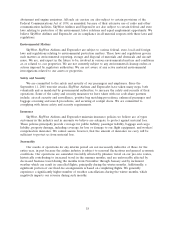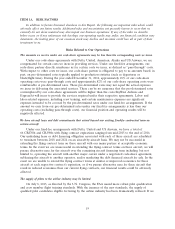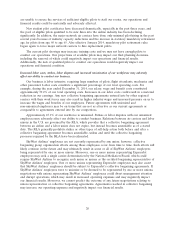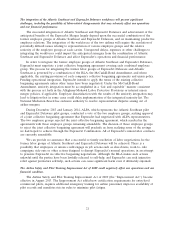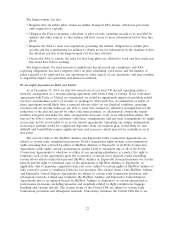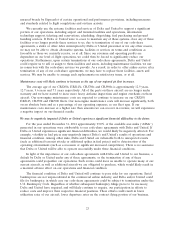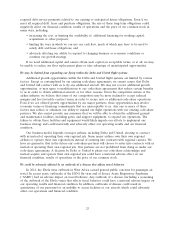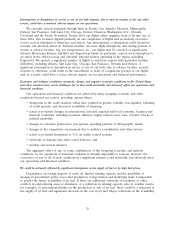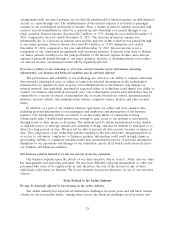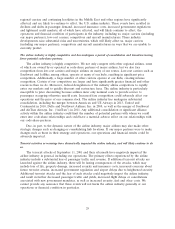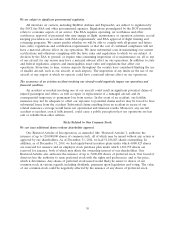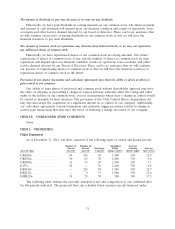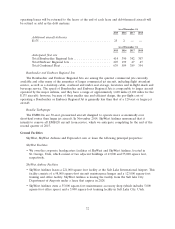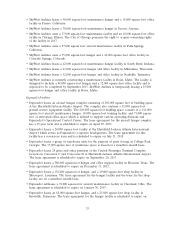SkyWest Airlines 2014 Annual Report Download - page 29
Download and view the complete annual report
Please find page 29 of the 2014 SkyWest Airlines annual report below. You can navigate through the pages in the report by either clicking on the pages listed below, or by using the keyword search tool below to find specific information within the annual report.more volatile operating margins and more aggressive contractual positions, which could result in
additional litigation. We believe that any of these developments could have a negative effect on many
aspects of our operations and financial condition.
Disagreements regarding the interpretation of our code-share agreements with our major partners could have
an adverse effect on our operating results and financial condition.
Long-term contractual agreements, such as our code-share agreements, are subject to
interpretation and disputes may arise under such agreements if the parties to an agreement apply
different interpretations to that agreement. Those disputes may divert management time and resources
from the core operation of the business, and may result in litigation, arbitration or other forms of
dispute resolution.
In recent years we have experienced disagreements with our major partners regarding the
interpretation of various provisions of our code-share agreements. Some of those disagreements have
resulted in litigation, and we may be subject to additional disputes and litigation in the future. Those
disagreements have also required a significant amount of management time, financial resources and
settlement negotiations of disputed matters.
To the extent that we continue to experience disagreements regarding the interpretation of our
code-share or other agreements, we will likely expend valuable management time and financial
resources in our efforts to resolve those disagreements. Those disagreements may result in litigation,
arbitration, settlement negotiations or other proceedings. Furthermore, there can be no assurance that
any or all of those proceedings, if commenced, would be resolved in our favor. An unfavorable result in
any such proceeding could have adverse financial consequences or require us to modify our operations.
Such disagreements and their consequences could have an adverse effect on our operating results and
financial condition.
We have a significant amount of contractual obligations.
As of December 31, 2014, we had a total of approximately $1.7 billion in total long-term debt
obligations. Substantially all of this long-term debt was incurred in connection with the acquisition of
aircraft, engines and related spare parts. We also have significant long-term lease obligations primarily
relating to our aircraft fleet. These leases are classified as operating leases and therefore are not
reflected as liabilities in our consolidated balance sheets. At December 31, 2014, we had 554 aircraft
under lease, with remaining terms ranging up to 11 years. Future minimum lease payments due under
all long-term operating leases were approximately $1.5 billion at December 31, 2014. At a 4.8%
discount factor, the present value of these lease obligations was equal to approximately $1.3 billion at
December 31, 2014. Our high level of fixed obligations could impact our ability to obtain additional
financing to support additional expansion plans or divert cash flows from operations and expansion
plans to service the fixed obligations.
Our anticipated fleet replacement would require a significant increase in our leverage and the related cash
requirements.
We currently have 246 CRJ200s with an average life of 12.9 years, 226 ERJ145s with an average
life of 12.7 years and 43 EMB120s with an average life of 17.3 years. We have announced our intention
to remove all of our EMB120s from service before the end of the second quarter of 2015, and we
anticipate that over the next several years, we will continue to replace the CRJ200s and ERJ145s with
larger regional jets or turboprops. Our fleet replacement strategy, if undertaken as we currently
anticipate, will require significant amounts of capital to acquire these larger regional jets or turboprops.
There can be no assurance that our operations will generate sufficient cash flow or liquidity to
enable us to obtain the necessary aircraft acquisition financing to replace our current fleet, or to make
24






